My grandmother, Agnes Rebecca Lofgreen Viles, was born in a small desert
town located in southeastern Arizona near the Arizona border. St. David,
Arizona was founded by early Mormon pioneers in the late 1800's. This is a
picture of "Granny" as a teenager sitting on the post of a barbed wire fence in
St. David. Every time I see this picture I wonder how she got up there without
hurting herself!
Cindy's List of Genealogy Sites
My Favorite Links
 BYU Home Page
BYU Home Page
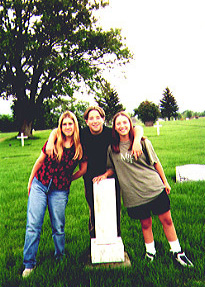
On June 10, 1997 I took my nephew, Brandon, and my nieces, Marie and
Lauren, to Huntsville, Utah, wanting them to learn something about their
heritage. One of the things we did was to find the grave of their 4th great grandfather, Anders Lofgreen, in the Huntsville City Cemetery.
The Lofgreen surname is an Americanized version of the Swedish surname,
Lofgren. Shortly after emigrating to Utah my 3rd great grandfather, Anders Persson Lofgren, Americanized his name to Andrew Peter Lofgreen, although the
Swedish branch of the family continues to use Lofgren.
Anders Persson Lofgren was born April 30, 1818 at Barseback, Harjagers harad,
Malmohus lan, Sweden. He was the son of Per Nilson Lofgren and Anna
Lars Dotter. Although Per was a blacksmith, he apparently was a heavy
drinker and drank away the money he earned. Per died when Anders was 2,
leaving his family in complete poverty. Because of this poverty, Anders was
already working for a local farmer by the time he was 7 years old. At other
times Anders and his siblings were forced to beg for food. Although life was
very tough for the family, Anders was willing to work hard and had a close
relationship with his mother and siblings.
While working on a farm in 1843 Anders met a young girl who would become
his wife 3 years later. Sissa Bengtsson was 17 years old when she and Anders
first met. Their courtship survived the normal struggles of young couples as
Anders worried about his friend who also liked Sissa. The other worry for
Anders was whether or not he could afford to take a wife, but three years later
permission was given by Sissa's parents, and the wedding took place in April of 1846 at the Billeberga Church.
My 2nd great grandfather,
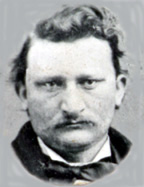 Pehr Andersson Lofgreen,
Pehr Andersson Lofgreen,
was the first child born into this family on 18 January 1847, born in Orfe, Malmohus, Sweden. It was a difficult time for Sissa, being forced to stay in bed 7 weeks after the birth of Pehr. Within a few years there were several more children born to Anders and Sissa. Botilla Lofgren was born 24 January 1848 in Hällstorp, Malmohus, Sweden. The following year, on 25 August, 1849, Anna Lofgren was welcomed into their home. Kjarsti Lofgren was born on 4 January 1851 followed by Bengt Lofgren on 1 July 1852. There was one stillborn baby born after this; however, Anders, in his autobiography, could not remember the date of birth. The final child born was Krestensa Lofgren on 11 January 1855. It was complications from this last birth which caused the death of Sissa on 27 January 1855 in Hallstorp,
Malmohus, Sweden. The baby, Krestensa, died 3 days later on 30 January
1855. Anders own words describe the feelings he had at this time:
"The birth of the last mentioned child became the death of my
highly beloved wife Sissa. In all my work, in all my troubles, in my care to supply my family with the necessities of life no sorrow ever hit me harder. After 16 days
of "hard" sickness (after the birth) the sharp arrow of death came on January
27 and ended her life here in time. What more could I do than weep and sorrow
over the loss of such a dear woman that she was to me.
The little babe that was born to me had some of the same sickness as my wife
for it died three days after her on January 30, they both had the same color after
death, namely yellow as a pea. Now she had left me with our five children to
care for the best I could. Before she was buried (which was a week) I went to her
and away again every day with bitter tears of sorrow running down my cheeks onto
her cold and stiff corps, but what comfort would it give me, none. I could talk to
her but the dead body could not answer. If her spirit was present (as many
think they are after death) and heard my sorrow, I think it had no permission to talk
to me.
He who loses a faithful and loving wife has certainly lost a pearl of great price.
For what is there here in life, which can more or better comfort a husband,
heavily laden in his hard work (to provide the earthly necessities of life) than to
meet (at finished work) a loving wife with a smile and a welcome kiss on her
lips.
We all have to leave and I was left alone here to care for all our children and
had to do it patiently. I pray that we may meet in glory again after I have
entered the grave and that all sorrows may be forgotten and that we may live
together forever."
Although suffering from the loss of his wife, Anders was forced to think about
what would be best for his children. His oldest daughter, Kjersti, went to live
with her mother's parents. The other four children remained with Anders. As
painful as it was, Anders knew that he would have to have help in raising these
little ones. Since he couldn't afford a maid and couldn't afford to stay at home
to raise them, Anders knew he would need to marry again as soon as possible.
Swedish law did not allow a re-marriage until 6 months after the death of the
previous spouse. Because of this, and since it was winter and there wasn't
much that could be done on the farm, Anders stayed home with the children to begin with. When the time came for Anders to start looking for a wife he
aggressively worked at finding one. Anders describes this time, in his autobiography, when he writes:
"Again I began to think of where I could find my good luck. I came to think of
a maid that worked for one of my neighbors, where I had been several times to
do some odd jobs. While there I had seen her do her job with such a speed that all
were more than satisfied. I wondered for myself if she would move over to
me.
Thus I went over to the woman that she had served with and asked how she
had behaved towards children, for I was not sure if she treated them correctly. I
understood that she was hot tempered. But the woman comforted me by
saying, that I could not find a better woman than she was. This was fine and the next question was if I could get her to move to me. I wanted to see her as I would
not let this problem rest until it was solved, and somebody accepted me. I
knew what the scripture says: For he who seeks shall find and for he who knocks
shall be opened.
I now went over to the place where the maid lived but did not find her home.
Her sister was home and I asked her if Kjersti (the name of the maid) was
home. She said that she was in Asmundtorp weaving. When I told the woman why I had come she did not think I was very lucky, as she told me another man had been
there a short while ago talking to Kjersti and now he wanted to marry her, but
she has decided to live alone. She wants Nils (her sister's husband) to add a
room at the west side of the house where she can live the rest of her life. I
do not think she will accept your offer.
I was told she would be home the following Sunday and I said that I would be
back and bid farewell to Parnila (the name of the woman) and went home to
wait for Sunday. It came and I was at Nils Andresson's again. Kjersti was home
and I think that her sister had told her that I had been looking for her and also
what I wanted, for when I asked her if she would marry me she was ready with
her yes, but she did not know when she could move over to me for she had a lot of
weaving to do.
I did not like this for I had lived on hope several times before and had been
disappointed, but this time my hope was not in vain as she was soon through
with her weaving and thus in April, 1855 she moved over to me at Halstorp (the
same parish as Billeberga, where she moved from) with the intention to marry me
when the time according to the law came for that, which was July 5 or thereafter.
We learned to know each other a little better before this time and when the
time came we were both satisfied to be united in marriage. She was hot tempered
but when I saw it I left her alone and she soon cooled off by herself. When we
were married I did not need any more of that hope I had had before. Kjersti
was a good wife to me. Sometimes she was a little strict towards the children
because of her "tamper." She could not stand to see them poorly dressed. She would rather work night and day to have them well dressed than to see them poorly
dressed.
 Now my troubles were ended how I would get somebody to move over to me.
Now I had a wife that was just as good as Sissa in taking care of the house and I
could go out and find work all the time our little farm allowed it. On December 17
she presented me with a son, who was given the name of Nils and whom she had
not intended to present to me until six weeks later. She was an old woman, 32,
when I married her. My love for Kjersti was not as great as for Sissa when I married her, but it grew all the time as we got to know each other better and we lived together as man and wife as good as the circumstances allowed."
Now my troubles were ended how I would get somebody to move over to me.
Now I had a wife that was just as good as Sissa in taking care of the house and I
could go out and find work all the time our little farm allowed it. On December 17
she presented me with a son, who was given the name of Nils and whom she had
not intended to present to me until six weeks later. She was an old woman, 32,
when I married her. My love for Kjersti was not as great as for Sissa when I married her, but it grew all the time as we got to know each other better and we lived together as man and wife as good as the circumstances allowed."
This was a time of financial struggle, as well as a time of change for the
Lofgreen family. LDS (Mormon) missionaries had come to the area of Sweden
where Anders family lived, and there was a great deal of conversation and
differing opinions about the message of the missionaries. Before the birth of
Anders and Kjersti's next child, Selia, who was born 19 November 1857,
Anders stated his opinion to his wife's midwife that he believed their message of
repentance was a good one. The midwife stated she thought the missionaries
were false prophets and told Kjersti to watch out because her husband was too
supportive of the missionaries. Kjersti's response was that she didn't care.
She just wanted the pain of having the child to be over with. It was two
years later before Anders actually had the opportunity to talk to an LDS
missionary.
Jons Jonsson was the first missionary that Anders and Kjersti really listened
to, and it wasn't long after that before both Kjersti and Anders were baptized
into The Church of Jesus Christ of Latter Day Saints. The decision was not
made without much prayer and religious study. It was also made even though
many of their friends and neighbors would no longer talk to them, associate
with them, or hire them to work on their farms and in their homes. One
neighbor even went so far as to threaten to cut Anders throat if he allowed
the Mormons to have meetings in his home.
Anders progressed in the Gospel very quickly and within a short period of time
he received the Melchizedek priesthood. Then in the spring of 1861 the
president of the local branch of the LDS church was released and Anders was
called and sustained to take his place.
Although Anders and Kjersti's decision to join the LDS church was a happy
one for them, they were not free from other personal trials. In April of 1861,
Selia, their three year old daughter, died. When Kjersti and a neighbor were
dressing the child in her funeral dress, Selia's older half-sister, Anna,
stood watching her little sister being dressed in a snow white funeral dress.
She began crying bitter tears and crying over the body of her little sister.
Then Anna stated that she wished she could follow Selia. Although she was
healthy and well at this time, Anna died within three days, causing Anders to
state in his journal that as hard as the loss was for him and Kjersti, they
felt that the Lord had answered the prayer of this grieving child. On
January 10, 1862 Kjersti and Anders were blessed by the birth of another
daughter, whom they named Cicelia, after their daughter who had died the year
before. The birth of this child helped to fill the empty spot in their
hearts, although nothing can take away the pain of losing a child.
Anders and Kjersti had already made the decision at this time to travel to
Utah and join the other members of the LDS faith. After the birth of their
child, Cicelia, they sold their home and farm, left some money with a trusted
friend as a dowery for Anders and Sissa's daughter, Kjarsti, who was living
with her maternal grandparents, and traveled to Malmö, Sweden, where they
were to board a ship to Copenhagen, and then on to the United States. They
boarded this ship on April 7, 1862, traveling first to Copenhagen, and then joining
the ship, Humboldt, and taking it to New York.
The Humboldt was a German ship built in 1853 by A. Meyer. The ship is 789 tons, with dimensions of 157' x 32' x 22'. The Shipmaster who commanded the vessel from Shipmaster 1858 to 1866 was Captain H. D. Boysen
The food on the boat consisted of soup, potatoes, beans, fish,
bread, or hardtack biscuits. The cooking was done in iron pots
so large the cook could get inside. No bread was made on the ship,
the biscuits having been made months before and were extremely
hard and dry. The potatoes were sour and soggy. The drinking water
was taken from the River Elbe, in Germany, put in wooden barrels,
that had been burned on the inside, and was as black as coal, when
we drank it. Water was also put in large iron barrels, holding
about five hundred gallons, and when the water from the wooden
barrels was exhausted, the water from the iron barrels was
used. This was red with rust. Pigs would object to the food and
water but had to take it.
The beds on the ship were made of common lumber, with room for
four in width and were two tiers high....
The Humboldt went down sometime in 1866.
The ship landed in New York on 2 June 1862.
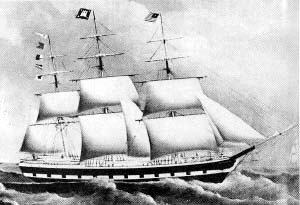
On the 4th of June the family boarded a train for St. Joseph,
Missouri, and from there they traveled up the Missouri River to Florence,
Nebraska, where the wagon trains were forming to travel to the Utah
Territory.
On July 24 the family started the long wagon train trip to Utah. The LDS
authorities had a very well organized system by this time to get their church
members to Utah. They had been making the trek to Utah since 1847. Several
families were assigned to each wagon and every widow was assigned to a
wagon with other families so that they would have the support of the men to help
them make the trek. Anders was responsible for a "very fine lady" as well as
two other families. Anders and his family were members of the John Murdock
wagon train, which arrived in Salt Lake City on September 27, 1862.
Although there was great excitement at finally having reached their destination,
there was also fear at their situation. The family set up a tent upon arriving
in the city, but realized that winter was soon coming and they had no home to
live in and only a few pieces of bread left. Almost all of those who traveled
with them to Salt Lake were met by family and friends but Anders and Kjersti
were met by no one. Kjersti and the children began to cry at this point and
it was left for Anders to show them love and comfort and to tell them that
"Heavenly Father would give us our necessities if we would serve him with
sincere hearts." Although he comforted his family, Anders was also fearful.
He had heard that friends he was hoping to join in Sanpete County had all died,
and there was no longer a support group there. That same day they arrived in
Salt Lake, an acquaintance from Sweden offered to rent them three rooms at
his home in Sugar House, for $1.50 per month. Although Anders felt this was
very unfair, he felt he had no choice but to accept the offer. The very next day,
Jons Jonsson, the missionary who first took them to an LDS meeting, came to
see Anders and his family, and helped Anders get work so that he could sustain
his family.
Since cash was so scarce in the Utah Territory, there was a very sophisticated
barter system. Everyone also had to learn to sustain themselves on what they
could grow and produce within the Territory. Two of the children, Bengt and
Botila, went into the wheat fields to pick what was left, gathering a
substantial amount before the snow fell. Kjersti knew how to spin but did not
have a spinning wheel so she traded a piece of silk she had to make a dress
for a spinning wheel. She then helped to support the family with her spinning.
When winter came Anders cut willows and made baskets for sale. He then cut
fir trees, split them, and made barrels and pails. When spring finally arrived
Anders looked for land he could buy or rent, in order to continue supporting
his family. He quickly realized that he could not afford to rent the land so he
and a friend did some searching for land. They found 10 acres of land with
water rights that belonged to the church. Then they went into Salt Lake City
to track down Elder Daniel H. Wells, who was in charge of church property.
Elder Wells informed Anders and his friend that they could have the land, so
they returned to the land, which was in Millcreek, and divided it. Each man
took four acres as 2 acres could not be used. The family lived in Millcreek for
2 1/2 years before moving to Huntsville, Utah, which is in the mountains
northeast of Salt Lake City. They arrived in Huntsville in November of
1865, arriving there "with 2 horses, a wagon, 3 milk cows, a full grown
heifer, and some other animals, like pigs and chickens."
After arriving in Huntsville, Anders built a dugout home on the town lot he had
obtained in the community. Anders made a stove from sheet iron which helped
to make the home more comfortable; however, there were still seven people
living in a dugout home that was roughly 12 feet by 14 feet. At bedtime
everyone would spread out their ticks or mattresses, stuffed with corn
husks, and their quilts for covers. There was no privacy in this situation
which must have been hard for my 2nd great grandfather, Pehr (Peter), who
had just married his bride, Johanna Sandberg. In order to feel as if they
had some independence, Johanna did her own cooking for her husband after
Kjersti had prepared the meal for the others in the home.
Winters in Huntsville could be difficult and that first winter Nils remembers
the snow being so deep that they sometimes had to burrow a tunnel out the door.
Once when the team of horses got away, it ran right over the top of the
house without knowing it because the snow was piled up level to the roof.
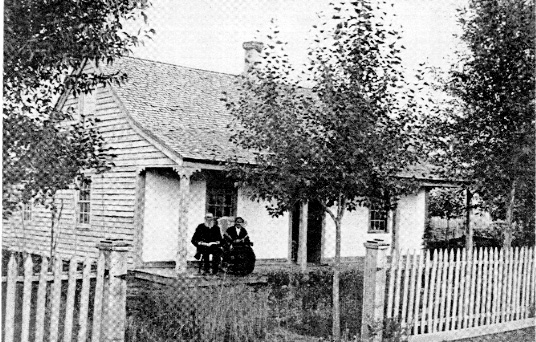
Spring finally came and that first year Anders finished a frame house with
real pine shingles that didn't leak. Anders also traded his horses and
harness for 20 acres of land in the north field. Then he asked a man, who
owed his wife for some weaving she had done, if he would plow the field to
pay off the debt. The man agreed and Anders was able to get his field planted.
Life was not easy for these pioneers as they had to struggle with repeated
late frosts which damaged the crops, and grasshoppers which ate the crops.
In addition to that there was the difficulty of a short growing season due
to the elevation of the town. Huntsville is at about 5,000 feet.
An interesting story about relations with the Ute and Shoshone tribes is told
by Ben E. Lofgren in the book he has compiled about Anders entitled, A
Simple Faith: Anders Persson Löfgren, Swedish Son — Mormon Immigrant.
Ben states;
On Thursday, August 16, 1866, a party of Indians arrived in the Ogden Valley,
made up of almost a thousand "men, squaws and papooses," from Ute and Shoshone
tribes. They camped about one mile west of Huntsville.
Generally the counsel of Church President Brigham Young concerning relations
with Indians was that it was better to feed them than to fight them, and
apparently town leaders decided to follow that philosophy.
On Sunday the chiefs were invited to attend the regular Huntsville Church
meetings, where President Francis Hammond called for the citizens of the
town to bring donations to the town square of food and gifts that would be
given to the Indians. The townspeople responded and the Indians came to
receive their presents. They formed a procession and marched slowly into
town, dancing at times, finally forming an immense ring in which the squaws
danced around and around. The Indians sang and played music as the town
residents watched in quiet amazement. In a final show, they staged a
demonstration of a recent battle in which seven Arapaho braves had been killed.
After the dancing, the Indians gathered around as town leaders presented them
with the various donated gifts. They included four beef, nine sheep, flour
and 50 to 75 bushels of carrots, potatoes and vegetables.
The Indians gathered their belongings and headed south to their winter camping
grounds with apparent good will among both groups. It wasn't the only time,
or even the last time, Huntsville citizens had dealings with Indians in Ogden
Valley, but it was the most impressive.
Some Huntsville residents described how anxious they were at different times
when they had meetings with the native residents of their new land.
Apparently, Indians coming in and out of the valley didn't particularly
concern Anders as he makes no mention of it in his autobiography. His
son Nils seemed to think that it was an interesting thing, noting that as
a young man he often enjoyed going to visit the Indian encampments that
might be nearby. "I would visit their camps and play with the papooses.
Those little fellows were great swimmers and were excellent marksmen with
bow and arrow."
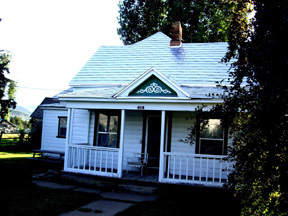

The Anders Lofgreen home as it looks in 2007
and the same home as it looked about 1875.
Full-size version of Anders Lofgreen Home about 1875 with Anders and Kjersti on
porch
Education was obviously important to Anders because in the summer of 1867 he worked on the new stone schoolhouse where his two youngest children were students. This schoolhouse was to replace the log schoolhouse the town had outgrown. In his journal he wrote that he "made 100 dollars which I donated to the school." Stonemasonry was one of his many trades because in the 1880 census for Weber County, his occupation was listed as "stone mason."
That same year of 1867 Anders and Kjersti went to the endowment house in Salt Lake City to receive their endowments and be sealed. He described a strange experience he and Kjersti had as they rode through the canyon to Salt Lake. "When we went through the mountains, something strange seemed to happen. It was just as if some clouds came, but there was no wind. We looked a little more closely and found some kind of flies flying so high that we could not see what they really looked like. When we came to "Kesvard" we could see what it was - "grasshoppers." The grasshoppers were a problem for the next seven years. At times men, women and children would gather to fight the grasshoppers, chasing them into holes and covering them with dirt.
Even with the grasshopper problem, Anders prospered, owning more acres than he could farm as well as his home, furniture, tools, animals, etc. On the 1870 census he is listed as having real estate valued at $400 and personal property of $500.
During the late 1860's the Transcontinental Railroad was being built, going through Utah near Huntsville. Anders and his son Bengt went over the mountains to Weber Valley to work on the rail lines. They stayed all winter and worked on the lines as far as Promontory, finishing on April 12, 1869. The Transcontinental Railroad was completed at Promontory Summit on May 10, 1869.
Although polygamy had been practice by a small percentage of LDS people, it did not affect the Lofgreen family until the late 1870's. In his journal Anders stated that, "he became involved in polygamy at the request of his wife Kjersti. As the family prosperity increased, she thought he should take another wife. Anders had serious doubts about this because of Kjersti's hot temper, but Kjersti was adamant and started looking for another wife in 1878. In November of 1878 Anders married Mette Marie Nielsen in the Endowment House in Salt Lake City. Anders says they all got along fairly well living in the same house as the wives had separate bedrooms. The situation only lasted for six months because in June of 1879, Kjersti died.
1882 and 1883 were busy years for the Lofgreen family as all of Ander's children returned to Huntsville, and then began to move away again starting in 1883. Within a few years it was only Anders and his wife, Mette, and the family of his son, NIls, who were left in the old homestead in Huntsville. Anders lived out the remainder of his life in Huntsville, Utah, dying in 1901. He is buried beside his two wives in the Huntsville cemetery. Nils continued to farm the land until his children moved away, and then he sold the family home in the 1920's to the Edgar Allen family. To the best of my knowledge, the home is still owned by the Allen family.

Email: me
